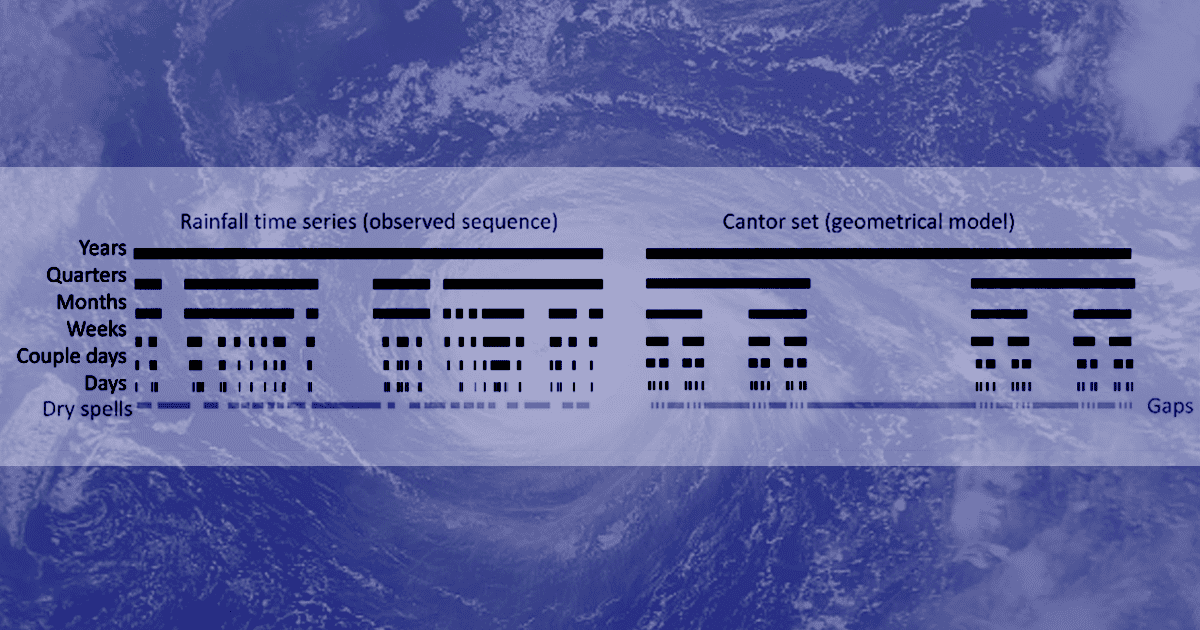- 2.3Impact Factor
- 4.9CiteScore
- 20 daysTime to First Decision
Geometry in Meteorology and Climatology
Special Issue Information
Dear Colleagues,
The atmosphere is a highly non-linear dynamic system, where equations can present some solutions known as strange attractors since they have non-integer dimensions, or in other words, fractional volumes. The fractality in meteorology and climatology is reflected in the self-similarity at different spatial and temporal scales. For instance, atmospheric patterns present quasiperiodic oscillations that are reproduced at all spatial scales (from the eddy and the polar vortex to the Quasi-Biennial Oscillation and the Arctic Oscillation). Other examples are the disaggregation methods of sub-daily rainfall and the distribution of dry spells within a drought, which closely resemble the gaps in the Cantor set. Therefore, this Special Issue aims to review the state of the art and boost cutting-edge methods in “Geometry in Meteorology and Climatology” by collecting original contributions covering transdisciplinary approaches. Due to the strong link between atmospheric sciences and mathematics, this Special Issue will be focused on geometrical methods applied to characterize, analyze, predict or attribute physical phenomena linked to atmospheric dynamics and the effects. This includes characterization by geometrical approaches such as multifractal cascading, time scaling, rainfall concentration and drought lacunarity, as well as an empirical orthogonal basis of atmospheric patterns, principal components, compound events and extreme value theory of atmospheric variables. This Special Issue also accepts advanced methods for climate change attribution analysis, forensic meteorology and hindcast or operational forecasting that use geometrical perspectives such as performance metrics in supervised learning algorithms, similarity measures and analogue stratification, among others. Finally, the geometrical interpretation of time series analysis (breaking points, transitivity, information power, entropy, and Lyapunov and Hurst exponents) should also be adjusted to the scope when atmospheric variables are a key part of the papers.
Dr. Robert Monjo
Guest Editor
Manuscript Submission Information
Manuscripts should be submitted online at www.mdpi.com by registering and logging in to this website. Once you are registered, click here to go to the submission form. Manuscripts can be submitted until the deadline. All submissions that pass pre-check are peer-reviewed. Accepted papers will be published continuously in the journal (as soon as accepted) and will be listed together on the special issue website. Research articles, review articles as well as short communications are invited. For planned papers, a title and short abstract (about 250 words) can be sent to the Editorial Office for assessment.
Submitted manuscripts should not have been published previously, nor be under consideration for publication elsewhere (except conference proceedings papers). All manuscripts are thoroughly refereed through a single-blind peer-review process. A guide for authors and other relevant information for submission of manuscripts is available on the Instructions for Authors page. Atmosphere is an international peer-reviewed open access monthly journal published by MDPI.
Please visit the Instructions for Authors page before submitting a manuscript. The Article Processing Charge (APC) for publication in this open access journal is 2400 CHF (Swiss Francs). Submitted papers should be well formatted and use good English. Authors may use MDPI's English editing service prior to publication or during author revisions.
Keywords
- fractal
- metrics
- similarity
- empirical orthogonal functions
- dimension reduction
- classification
- time series analysis
- supervised learning

Benefits of Publishing in a Special Issue
- Ease of navigation: Grouping papers by topic helps scholars navigate broad scope journals more efficiently.
- Greater discoverability: Special Issues support the reach and impact of scientific research. Articles in Special Issues are more discoverable and cited more frequently.
- Expansion of research network: Special Issues facilitate connections among authors, fostering scientific collaborations.
- External promotion: Articles in Special Issues are often promoted through the journal's social media, increasing their visibility.
- e-Book format: Special Issues with more than 10 articles can be published as dedicated e-books, ensuring wide and rapid dissemination.

